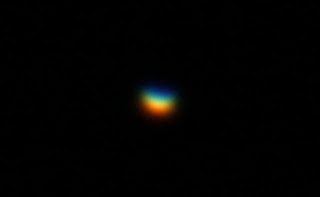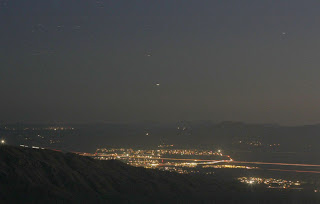 I've mentioned the Green Flash before - it is normally a vivid spot of green that becomes visible as the last piece of sun remains on the horizon. I've also talked about how it is formed in a previous post about imaging crescent Mercury (shown at left here). At very low angles above the horizon, the atmosphere acts like a thin prism, and as I demonstrated in last night's post, a prism will break the light into the colors of the rainbow. So the atmosphere does the same thing - the upper edge of an astronomical body, be it the sun, a crescent Mercury or a star, appears bluish or green, the lower edge appears red. This is a different effect than a rising or setting sun or moon appearing reddish - that is just the longer path length through the atmosphere of a low object scattering the shorter wavelengths more.
I've mentioned the Green Flash before - it is normally a vivid spot of green that becomes visible as the last piece of sun remains on the horizon. I've also talked about how it is formed in a previous post about imaging crescent Mercury (shown at left here). At very low angles above the horizon, the atmosphere acts like a thin prism, and as I demonstrated in last night's post, a prism will break the light into the colors of the rainbow. So the atmosphere does the same thing - the upper edge of an astronomical body, be it the sun, a crescent Mercury or a star, appears bluish or green, the lower edge appears red. This is a different effect than a rising or setting sun or moon appearing reddish - that is just the longer path length through the atmosphere of a low object scattering the shorter wavelengths more.Most amateur astronomers are familiar with telescopic views of the planets or Moon when they hang low in the sky. The side nearest the horizon is reddish, the higher side blue. Again, this is caused by atmospheric dispersion. But the disk of a planet or moon is still mostly white. A star, however, not showing a true disk, can take on the appearance of a spectrum, especially if it is very low in the sky.
 I've been waiting a few months to document this observation, and Saturday everything came together to take a picture of Achernar, the 10th brightest star in the sky. The reason you likely haven't heard of it is that it is a southern hemisphere object, located at -57.25 degrees south, meaning that from Geology Vista's 32.4 degrees north latitude, it clears the horizon by less than half a degree (90-32.4=57.6). Being up on a mountain helps, and the atmosphere helps too by making it appear higher than it would be from an airless world by about a half degree. So Achernar should appear less than 2 degrees at it's highest. It was visible to the naked eye twinkling over the lights of Vail 25 miles to the south as the twilight glow faded in the southwest.
I've been waiting a few months to document this observation, and Saturday everything came together to take a picture of Achernar, the 10th brightest star in the sky. The reason you likely haven't heard of it is that it is a southern hemisphere object, located at -57.25 degrees south, meaning that from Geology Vista's 32.4 degrees north latitude, it clears the horizon by less than half a degree (90-32.4=57.6). Being up on a mountain helps, and the atmosphere helps too by making it appear higher than it would be from an airless world by about a half degree. So Achernar should appear less than 2 degrees at it's highest. It was visible to the naked eye twinkling over the lights of Vail 25 miles to the south as the twilight glow faded in the southwest. But in a telescope, as the light travelled through more than a dozen times a single air mass, it was transformed into a living writhing (from atmospheric turbulence) spectrum, red at the bottom, blue on top. There was no colorless disk - the point of the star was a pure spectrum, transformed by the prismatic effect of the Earth's atmosphere. Shown here is a stack of 10 frames, each 2 seconds duration, which gets close to the visual effect of the low star. This is slightly cropped from an image with the C-14 telescope, about 4,000mm focal length.
But in a telescope, as the light travelled through more than a dozen times a single air mass, it was transformed into a living writhing (from atmospheric turbulence) spectrum, red at the bottom, blue on top. There was no colorless disk - the point of the star was a pure spectrum, transformed by the prismatic effect of the Earth's atmosphere. Shown here is a stack of 10 frames, each 2 seconds duration, which gets close to the visual effect of the low star. This is slightly cropped from an image with the C-14 telescope, about 4,000mm focal length.Back in the "olden days" at the University of Iowa working at the observatory, we observed stars low in the sky, to calibrate the atmospheric transmission as a function of wavelength and air mass. Oftentimes we noted the transformation of star images into little spectra, and we had to note which part of the spectrum we were observing at any time to make sure that star's color was going into the slit. Observing and documenting the effect certainly brings back memories of those days!














1 comment:
Great shots and explanation Dean. I see this effect all the time at the 90 inch telescope - even with stars at elevations as high as 45 degrees. Makes high definition imaging with bayer mask detectors a real trial. Thanks!
Post a Comment